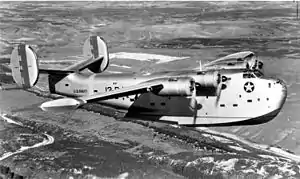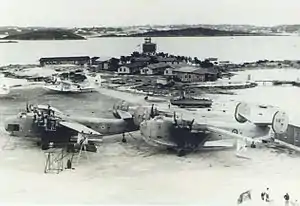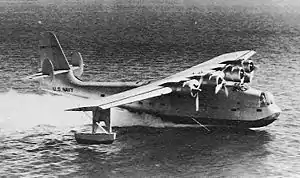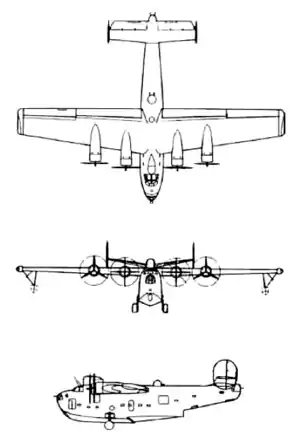Consolidated PB2Y Coronado
The PB2Y Coronado is a large flying boat patrol bomber designed by Consolidated Aircraft, and used by the US Navy during World War II in bombing, antisubmarine, and transport roles. Obsolete by the end of the war, Coronados were quickly taken out of service. Only one known example remains, at the National Naval Aviation Museum at Naval Air Station Pensacola, Florida.
| PB2Y Coronado | |
|---|---|
 | |
| An early PB2Y-2 in flight. | |
| Role | Maritime patrol bomber |
| Manufacturer | Consolidated Aircraft |
| First flight | 17 December 1937 |
| Status | Retired |
| Primary users | United States Navy Royal Air Force |
| Number built | 217 |
Design and development
After deliveries of the PBY Catalina, also a Consolidated aircraft, began in 1935, the United States Navy began planning for the next generation of patrol bombers. Orders for two prototypes, the XPB2Y-1 and the Sikorsky XPBS-1, were placed in 1936; the prototype Coronado first flew in December 1937.[1]
After trials with the XPB2Y-1 prototype revealed some stability issues, the design was finalized as the PB2Y-2, with a large cantilever wing, twin tail with very marked dihedral, and four Pratt & Whitney R-1830 radial engines. The two inner engines were fitted with four-bladed reversible pitch propellers; the outer engines had standard three-bladed feathering props.[2] Like the PBY Catalina before it, the PB2Y's wingtip floats retracted to reduce drag and increase range, with the floats' buoyant hulls acting as the wingtips when retracted. The price of the PB2Y-2 was US$300,000, or approximately three times that of the PBY Catalina.[3]
Development continued throughout the war. The PB2Y-3, featuring self-sealing fuel tanks and additional armor, entered service just after the attack on Pearl Harbor and formed most of the early-war Coronado fleet. The prototype XPB2Y-4 was powered by four Wright R-2600 radials and offered improved performance, but the increases were not enough to justify a full fleet update. However, most PB2Y-3 models were converted to the PB2Y-5 standard, with the R-1830 engines replaced with single-stage R-1830-92 models. As most existing PB2Y-3s were used as transports, flying low to avoid combat, removing the excess weight of unneeded superchargers allowed an increased payload without harming low-altitude performance.[4]
Operational history

Coronados served in combat in the Pacific with the United States Navy, in both bombing and antisubmarine roles. PB2Y-5 Coronados carried out four bombing raids on Wake Island between 30 January and 9 February 1944.[3] However, most served as transport and hospital aircraft.
The British Royal Air Force Coastal Command had hoped to use the Coronado as a maritime patrol bomber, as it already used the PBY Catalina. However, the range of the Coronado (1,070 miles) compared poorly with the Catalina (2,520 mi), and the Short Sunderland (1,780 mi). Consequently, the Coronados supplied to the RAF under Lend-Lease were outfitted purely as transports, serving with RAF Transport Command. The 10 aircraft were used for transatlantic flights, staging through the RAF base at Darrell's Island, Bermuda, and Puerto Rico, though the aircraft were used to deliver vital cargo and equipment in a transportation network that stretched down both sides of the Atlantic, from Newfoundland, to Brazil, and to Nigeria, and other parts of Africa. After the war ended five of the RAF aircraft were scrapped, one was already lost in collision with a Martin PBM Mariner and the last four were scuttled off the coast of Bermuda in 1946.[5]
Coronados served as a major component in the Naval Air Transport Service (NATS) during World War II in the Pacific theater. Most had originally been acquired as combat patrol aircraft, but the limitations noted above quickly relegated them to transport service in the American naval air fleet also. By the end of World War II, the Coronado was outmoded as both a bomber and a transport, and virtually all of them were quickly scrapped by the summer of 1946, being melted down to aluminum ingots and sold as metal scrap,[6] or used as targets for fighter gunnery practice.[3]
Variants

- Coronado I
- RAF Designation for PB2Y-3
- XPB2Y-1
- Prototype with four 1,050 hp (780 kW) Pratt & Whitney XR-1830-72 Twin Wasps, engines, one built.
- PB2Y-2
- Evaluation variant with four 1,020 hp (760 kW) Pratt & Whitney R-1830-78 Twin Wasp engines, modified hull and six 0.5 in (13 mm) guns, six built.
- XPB2Y-3
- One PB2Y-2 converted as prototype for PB2Y-3.
- PB2Y-3
- Production variant with four 1,200 hp (890 kW) Pratt & Whitney R-1830-88 Twin Wasp engines and eight 0.5 in (13 mm) guns, 210 built.
- PB2Y-3B
- Lend-lease designation for Royal Air Force aircraft.
- PB2Y-3R
- PB2Y-3s converted by Rohr Aircraft Corp as freighters with faired-over turrets, side loading hatch, and seating for 44 passengers, 31 built.
- XPB2Y-4
- One PB2Y-2 re-engined with four 1,600 hp (1,200 kW) Wright R-2600 Cyclone 14 engines.
- XPB2Y-5
- The XP2BY-3 converted as PB2Y-5 prototype.
- PB2Y-5
- PB2Y-3s converted with four 1,200 hp (890 kW) Pratt & Whitney R-1830-92 Twin Wasp engines, increased fuel capacity and provision for RATOG (rocket assisted take-off gear).
- PB2Y-5R
- PB2Y-5s converted as unarmed transports, some fitted for medical evacuation role.
Operators
Surviving aircraft
Specifications (PB2Y-5)

Data from Jane's Fighting Aircraft of World War II[2]
General characteristics
- Crew: ten
- Length: 79 ft 3 in (24.2 m)
- Wingspan: 115 ft 0 in (35 m)
- Height: 27 ft 6 in (8.4 m)
- Wing area: 1,780 sq ft (165 m2)
- Empty weight: 40,850 lb (18,530 kg)
- Max takeoff weight: 66,000 lb (30,000 kg)
- Powerplant: 4 × Pratt & Whitney R-1830-92 radial engines, 1,200 hp (900 kW) each
Performance
- Maximum speed: 194 mph (310 km/h, 168 kn)
- Cruise speed: 170 mph (272 km/h, 148 kn)
- Range: 1,070 mi (1,720 km, 930 nmi) at 131 mph (210 km/h)
- Service ceiling: 20,500 ft (6,250 m)
Armament
- Guns:
- 6× .50 in (12.7 mm) M2 Browning machine guns in twin nose, dorsal, and tail powered turrets
- 2× .50 in M2 Browning machine guns in manual waist mounts
- Bombs:
- 2× Mark 13 torpedoes or
- Up to 12,000 lb (5,400 kg) of bombs, housed in the wings
In popular culture
Victor Bergeron created a PB2Y cocktail for his Tiki bars (Trader Vic's) in honor of World War II airmen.[8]
See also
Related development
Aircraft of comparable role, configuration, and era
Related lists
References
Notes
- Andrews 1989, pp. 22–23.
- Bridgeman 1946, pp. 218–219.
- Burney 2015, pp. 82–87.
- Pruitt, James Robert (April 2015). "PB2Y Coronado Flying Boat Archaeology and Site Formation Studies Tanapag Lagoon, Saipan" (PDF). CORE. pp. 62–70. Retrieved 30 September 2018.
- March 2000, p. 63.
- Naval Aviation News & September 1946, p. 9.
- "PB2Y Coronado." National Naval Aviation Museum. Retrieved: 6 June 2015.
- "Trader Vic's". Life. 17 (10). September 4, 1944.
Bibliography
- Andrews, Hal. ""PB2Y Coronado." Naval Aviation News, Vol. 72, Issue no. 1, November–December 1989. ISSN 0028-1417.
- Bridgeman, Leonard. “The Consolidated Vultee Model 29 Coronado.” Jane's Fighting Aircraft of World War II. London: Studio, 1946. ISBN 1-85170-493-0.
- Burney, Allan. Flying Boats of World War 2 (The Aeroplane & Flight Magazine Aviation Archive Series). London: Key Publishing Ltd., 2015. ISBN 978-1-909786-110.
- Green, William. War Planes of the Second World War, Volume Five: Flying Boats. London: Macdonald & Co. (Publishers) Ltd., 1962 (Fifth impression 1972). ISBN 0-356-01449-5.
- Hoffman, Richard Capt. USN (ret.). Consolidated PB2Y Coronado (Naval Fighters 85). Simi Valley, California, USA: Ginter Books, 2009. ISBN 978-0-942612-85-1.
- March, Daniel J. British Warplanes of World War II. Rochester, Kent, UK: Grange Books Plc., 2000. ISBN 1-84013-391-0.
- Mondey, David. The Hamlyn Concise Guide to American Aircraft of World War II. London: Hamlyn Publishing Group Ltd., 1982 (republished 1996 by the Chancellor Press, reprinted 2002). ISBN 1-85152-706-0.
External links
| Wikimedia Commons has media related to Consolidated PB2Y Coronado. |
- Consolidated PB2Y Coronado at www.daveswarbirds.com
- Consolidated PB2Y Coronado at www.militaryfactory.com
- 1943 article including photos and cutaway drawing of PB27, starting bottom of page 121